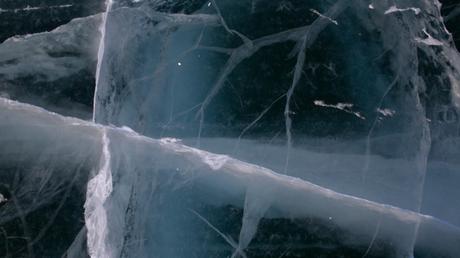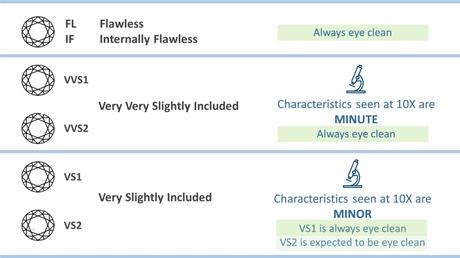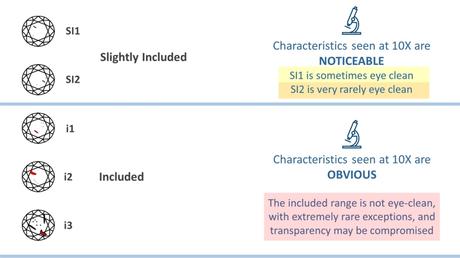Clarity evaluates a gemstone's internal and external clarity characteristics. Internal characteristics are called inclusions. These can be elements that were trapped in the stone as it grew or structural defects in the crystal lattice. External characteristics are classified as blemishes. These can be growth-related or they can be caused during wear.
"During wear? Wait - aren't diamonds super-hard?"Yes, but they can damage each other. Earrings stored together can scratch each other. Scratches and nicks can occur if diamonds in bands you wear next to each other have their girdles rubbing together while on your finger. Diamond crystals also have vulnerable cleavage planes, which means even the most flawless diamond can chip if it takes a knock against a hard surface the wrong way.

Pro-tip: Read about Jewelry Insurance here.
Diamond Clarity Grading
A gemologist analyzes clarity by looking down through the top of the stone at 10-power (10X) magnification. All inclusions and blemishes seen at 10X are considered when deciding the clarity grade. There are 11 different clarity grades. The cleanest is "Flawless (FL)." The least-clean is "Included 3 (I3)," often used for stones with inclusions that compromise durability. You can learn more about the 11 different grades on our education page about Diamond Clarity, or watch the quick summary video below.
"What is a good diamond clarity grade?"
Let's start by staying safe. Most people will agree that diamonds with issues that threaten durability are not desirable. That excludes the majority of diamonds at the bottom of the scale in the Included 3 (I3) and Included 2 (I2) categories. It also makes certain characteristics appearing in diamonds in the Included 1 (I1) and Slightly Included (SI2 and SI1) ranges worthy of case by case examination. For the most part, however, diamonds I1 and above are good to go for setting and daily wear.
With that said, a lot of diamond buyers have preconceived notions about clarity. These may have to do with what they learned growing up, what their circle of friends and family have to say, or what they have read on the internet (hello).
Preconceptions are fine, as long as they're grounded in fact. If you decide to stay with the very highest clarity grades as a mind-over-matter exercise or family tradition (rather than misinformation) then those are good clarity grades for your purposes. If you're operating on bad info or live exposure to clarity grading that wasn't performed by a top-tier laboratory, you may want to reconsider those limitations - learn a bit more - and save a few dollars in the process.
Nature's birthmarks? Or unsightly specks?
This is a key question. What do you think? Are any inclusions icky or are some kind of cool? There's no wrong answer but there are many different philosophies regarding diamond and gemstone clarity. Should a diamond be allowed to have few blemishes, even if they're barely visible, or should it be as clean as the pure-driven snow? The answer depends on the wearer's personal preference.
The "Eye-Clean" category
Reversing the question, many people aren't concerned with finding a single "good" clarity grade at all. They just want their gemstones to be "eye-clean," with nothing to distract from the material aesthetic. What is "eye-clean?" According to a PriceScope survey of gemologists, the definition of eye-clean is as follows:
No inclusions visible to the unaided eye when viewed from the face up position in daylight equivalent or fluorescent lighting from approximately 6-12 inches from the eye using 20/20 vision.
However... Laboratories Don't Judge Eye-Clean
Remember that diamond grading laboratories analyze clarity at 10X magnification and set the grade using that view. They make no determination about whether you (or the average viewer, or someone using the eye-clean definition above) will detect inclusions or blemishes. This means a couple of neighboring grades will include diamonds with - and completely without - visible inclusions.
For people seeking eye-clean clarity, there is great news. When graded by a top-tier laboratory, round brilliant diamonds with VS2 clarity and higher are reliably eye-clean. For shapes which show inclusions more easily (step cuts like emeralds and Asschers) VS2 clarity should be checked on a case by case basis.
Even better? You can frequently find diamonds with SI1 clarity which are eye-clean. And it's rare, but sometimes you might even find a SI2 diamond that meets the definition.
Eye-Clean Clarity Chart


Hidden Treasures
For those who are simply seeking an eye-clean diamond, there are "hidden treasures" in the SI1 and SI2 grades. These diamonds with no visible inclusions, appear just as clean as VS, VVS, and Flawless diamonds to the naked eye, and thus represent great savings in this "C."
What do you think?
Nature's birthmarks? Or unsightly specks? What about a ruby-red garnet trapped inside a colorless diamond?

Would you?
Summary
Bringing clarity to all of the above (see what I did there?) the only person who can determine "What is a good diamond clarity" - - - is you.
Written by John Pollard
Comments?
Do you consider visible characteristics "birthmarks" which make a diamond special or distracting and intolerable? Are you okay with a diamond that has characteristics that only become visible in certain lighting if you know where to look? Are you okay with any diamond which is clean to your eyes in all conditions? Do you prefer to stay at higher clarity grades on principal, as a mental thingy? Do you pursue collection quality diamonds of the highest clarities and colors for their enduring value? Do you like the fact that some people can buy lower clarity diamonds as they age, based on changing eyesight? If you found a diamond with visible inclusions that spelled your initials would you want it? That's a silly question, right, since you'd probably want any diamond you just "found!"
More Reading
Learn how to define brightness, leakage, contrast, and scintillation on our page Diamond Performance Explained.
Get fast answers to any question: Ask our community of unbiased independent helpers.Take your diamonds on a brightness, fire, and sparkle test drive: Make Comparisons Like an Expert.
Ready to find your diamond?
